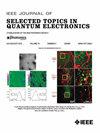单层/多层MoS2场效应晶体管光电探测器的建模与改进
IF 5.1
2区 工程技术
Q1 ENGINEERING, ELECTRICAL & ELECTRONIC
IEEE Journal of Selected Topics in Quantum Electronics
Pub Date : 2025-04-03
DOI:10.1109/JSTQE.2025.3557583
引用次数: 0
摘要
利用Silvaco公司的ATLAS器件模拟器对单层MoS2和多层MoS2场效应晶体管光电探测器模型进行了仿真和分析。分析了两种场效应晶体管光电探测器模型的光谱响应、响应率和转移特性。我们证明了单层MoS2光电晶体管产生的光电流仅取决于恒定漏极或栅极电压下的照明光功率。具有良好的稳定性和光响应特性。与单层MoS2光电晶体管相比,多层MoS2光电晶体管表现出更好的光电性能,包括更宽的光谱响应和更高的响应率。这些模拟结果与以往的实验数据基本一致。这些工作对过渡金属二硫系先进光电探测器的设计和研制具有重要意义。本文章由计算机程序翻译,如有差异,请以英文原文为准。
Modeling and Improvement of Single-Layer MoS2/Multilayer MoS2 Field Effect Transistor Photodetectors
The single-layer MoS2 and multilayer MoS2 field-effect transistor photodetector models were simulated and analyzed by ATLAS device simulator of Silvaco. The spectral response, responsivity and transfer characteristics of the two field-effect transistor photodetector models were analyzed, respectively. We show that the photocurrent generated by a single-layer MoS2 phototransistor depends solely on the illumination optical power at constant drain or gate voltage. And it shows good stability and photoresponse characteristics. In contrast, the modeled multilayer MoS2 phototransistor exhibits better photovoltaic performance than the single-layer MoS2 phototransistor, including wider spectral response and higher responsivity. These simulation results are basically consistent with the previous experimental data. These works are of great significance for the design and development of transition metal dichalcogenide-based advanced photodetectors.
求助全文
通过发布文献求助,成功后即可免费获取论文全文。
去求助
来源期刊

IEEE Journal of Selected Topics in Quantum Electronics
工程技术-工程:电子与电气
CiteScore
10.60
自引率
2.00%
发文量
212
审稿时长
3 months
期刊介绍:
Papers published in the IEEE Journal of Selected Topics in Quantum Electronics fall within the broad field of science and technology of quantum electronics of a device, subsystem, or system-oriented nature. Each issue is devoted to a specific topic within this broad spectrum. Announcements of the topical areas planned for future issues, along with deadlines for receipt of manuscripts, are published in this Journal and in the IEEE Journal of Quantum Electronics. Generally, the scope of manuscripts appropriate to this Journal is the same as that for the IEEE Journal of Quantum Electronics. Manuscripts are published that report original theoretical and/or experimental research results that advance the scientific and technological base of quantum electronics devices, systems, or applications. The Journal is dedicated toward publishing research results that advance the state of the art or add to the understanding of the generation, amplification, modulation, detection, waveguiding, or propagation characteristics of coherent electromagnetic radiation having sub-millimeter and shorter wavelengths. In order to be suitable for publication in this Journal, the content of manuscripts concerned with subject-related research must have a potential impact on advancing the technological base of quantum electronic devices, systems, and/or applications. Potential authors of subject-related research have the responsibility of pointing out this potential impact. System-oriented manuscripts must be concerned with systems that perform a function previously unavailable or that outperform previously established systems that did not use quantum electronic components or concepts. Tutorial and review papers are by invitation only.
 求助内容:
求助内容: 应助结果提醒方式:
应助结果提醒方式:


